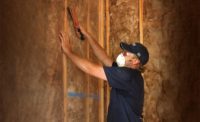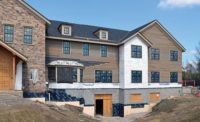With green building technology entering the mainstream and eco-home concepts spreading their roots faster than ever, the need for designing high-performance building envelopes is repeatedly highlighted. Efficient air barriers that typically define the pressure boundaries of a building’s enclosure and are responsible for prevention of air leakage, present an ultimate solution. Air barriers provide structure with an insulated and breathable structural sheathing, thereby rendering them the desired sustainability quotient.
Why are end-use consumers registering inclination towards efficient air barrier products?
Clearly, to curtail their utility bills, maintain the best possible indoor air quality, prevent the loss of conditioned air, and keep the moisture penetration at bay. While these represent the typical outcomes that are often expected of air barrier installations, selection of effective air barrier products is subject to a regulatory framework that keeps a check on certain parameters defining their performance in terms of air permeance. Increasing stringency of building codes and regulations are expected to pose a major impact on long-term growth of air barrier market. The latest International Energy Conservation Code (IECG 2015) mandates about a 30 percent increase in building insulation investments, which highlights an attractive opportunity for manufacturers of air barrier products and materials. In backdrop of increasing awareness about how critically air leakage can damage residential, commercial, as well as commercial building structures, sales of air barriers are witnessing a strong boost.
About the most preferred and popularizing air barrier products in global market
By the year 2020, global air barrier sales will possibly surpass a value of USD $15 Billion, which are projected for a promising yearly growth of around 4.5 percent. These projections are predominantly driven by a notable rise in the number of building and construction projects across the globe. Green building technologies will be an impactful trend shaping rapid progress in demand for air barriers over the near future.
Gypsum board, sprayed polyurethane foam (SPF) or spray foam, liquid-applied membranes, and polyethylene (PE) or polypropylene (PP) building wraps have been among the popularly sought-after air barrier materials. Research suggests that although gypsum boards continue to be the material of choice owing to its economic costs, it has been losing its market value share to spray foam since the past few years. The latter currently accounts for over 20 percent of total air barrier sales. While gypsum board lags in terms of durability, spray foam is highly durable and helps to achieve around 50 percent saving on energy costs. Moreover, the latter is compatible with both commercial and residential building structures. On the other hand, a collective share of OSB (oriented strand board) and plywood roughly equates more than 1/3 of the total market value of air barriers.
The bottom line revolves around energy efficiency and sustainability
Regulatory mandates regarding energy-efficient walls have been driving air barrier sales at a stable pace. Pertaining to the energy efficiency that remains at the heart of such regulatory codes, manufacturers of air barrier materials and products are emphasizing development of sustainable offerings that are more efficient, more effective, and possess multiple functionalities in sync with energy efficiency requisites.
Research has proven time and again that the market value of environmentally sustainable and natural air barriers will always remain attractive. It has observed that preference for traditional insulation materials such as fiberglass and cellulose remains sustained, attributing to their eco-friendly nature. Companies manufacturing spray foam insulation products are particularly focusing on innovative, environmentally-sensitive solutions. Icynene, a premium spray foam insulation manufacturer, offers a 100 percent water-blown spray foam solution. This low-GWP (global warming potential) solution is devoid of any ozone-depleting substances or synthetic blowing agents.
Insights presented in this article are based on a recent report published on the global air barrier market, by Future Market Insights (FMI).






Report Abusive Comment